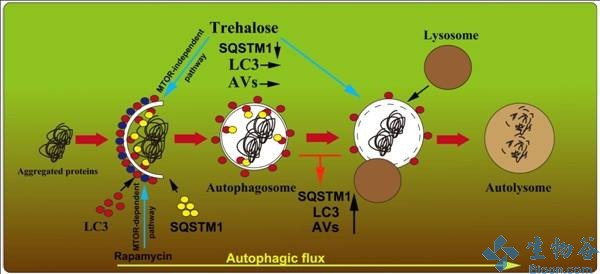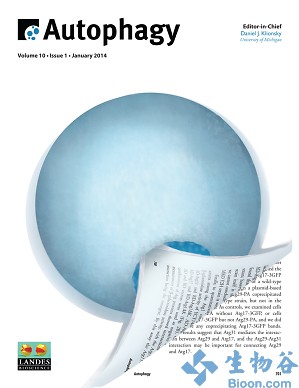2014年1月25日 讯 /生物谷BIOON/ --2014年1月15日,国际生物医学重要期刊Autophagy《自噬》(影响因子12.04)在线发表了中科院上海生命科学研究院/上海交通大学医学院健康科学研究所及上海交通大学医学院神经病学研究所乐卫东教授研究组的研究论文"MTOR非依赖自噬激活剂海藻糖通过调控体内自噬通量保护肌萎缩侧索硬化症(ALS)模型小鼠的存活"( MTOR-independent, autophagic enhancer trehalose prolongs motor neuron survival and ameliorates the autophagic flux defect in a mouse model of amyotrophic lateral sclerosis)。该研究发现ALS的发生与运动神经元内自噬通量异常密切相关,而MTOR非依赖自噬激活剂海藻糖能够改善自噬通量,保护运动神经元,显著延长模型小鼠的生存时间。
ALS是最为常见的一种成人运动神经神经元疾病,至今缺乏特异的治疗药物,研究发现运动神经元内蛋白质的异常累积可能在其选择性退行性变过程中起重要作用。自噬和蛋白酶体是胞内蛋白质降解的两条主要途径,其中自噬主要负责降解聚集状蛋白质。课题组前期研究报道了ALS中自噬水平的异常增高,而其在疾病发生发展过程中的作用及机制尚未阐明。在乐卫东教授的指导下,博士研究生张晓洁和陈晟等利用SOD1-G93A模型小鼠,首次发现并报道了ALS中自噬通量的异常,尤其是自噬小体与溶酶体的结合过程出现障碍。进而发现MTOR非依赖自噬激活剂海藻糖能够通过促进自噬小体与溶酶体的融合,加速聚集状蛋白质的降解,从而保护运动神经元的存活,延缓疾病的发生发展。同时,研究发现海藻糖还具有保护线粒体功能,延缓ALS骨骼肌的退化,对抗凋亡发生等多种神经保护作用。
该项研究在前期工作的基础上,国际上首次提出了ALS中自噬通量异常是ALS发病的一个新机制,并将目标集中于自噬小体与溶酶体融合过程,为ALS的治疗新靶点提供了理论依据。进一步研究发现海藻糖对ALS中自噬通量的改善及其在模型小鼠中的神经保护作用,其可能为临床ALS的治疗潜在药物。此外,研究结果对以胞内蛋白聚集为特征的其他神经退行性疾病如帕金森症、阿尔茨海默症的研究提供了积极的借鉴意义。
此课题得到了国家自然科学基金,科技部973项目及教育部博士点基金的资助。(生物谷Bioon.com)

自噬在肌萎缩侧索硬化发病中的作用及海藻糖作用靶点示意图
生物谷推荐英文摘要:

Autophagy PMID: 24441414
MTOR-independent, autophagic enhancer trehalose prolongs motor neuron survival and ameliorates the autophagic flux defect in a mouse model of amyotrophic lateral sclerosis
Xiaojie Zhang, Sheng Chen, Lin Song, Yu Tang, Yufei Shen, Jia Li, Weidong Le
Amyotrophic lateral sclerosis (ALS) is a devastating neurodegenerative disorder caused by selective motor neuron degeneration. Abnormal protein aggregation and impaired protein degradation pathways may contribute to the disease pathogenesis. Although it has been reported that autophagy is altered in patients and animal model of ALS, little is known about the role of autophagy in motor neuron degeneration in this disease. Our previous study shows that rapamycin, an MTOR-dependent autophagic activator, accelerates disease progression in the SOD1G93A mouse model of ALS. In the present report, we have assessed the role of the MTOR-independent autophagic pathway in ALS by determining the effect of the MTOR-independent autophagic inducer trehalose on disease onset and progression, and on motor neuron degeneration in SOD1G93A mice. We have found that trehalose significantly delays disease onset prolongs lifespan, and reduces motor neuron loss in the spinal cord of SOD1G93A mice. Most importantly, we have documented that trehalose decreases SOD1 and SQSTM1/p62 aggregation, reduces ubiquitinated protein accumulation and improves autophagic flux in the motor neurons of SOD1G93A mice. Moreover, we have demonstrated that trehalose can reduce skeletal muscle denervation, protect mitochondria and inhibit the proapoptotic pathway in SOD1G93A mice. Collectively, our study indicates that the MTOR-independent autophagic inducer trehalose is neuroprotective in the ALS model and autophagosome-lysosome fusion is a possible therapeutic target for the treatment of ALS.